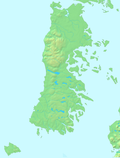Isla Guafo
Biodiversity
Guafo Island is characterized by a high biodiversity that includes the largest breeding colony of South American fur seals (Arctophoca australis) on Chilean coasts, a large population of South American sea lions (Otaria byronia), and a reproductively active population of marine otters (Lontra felina), a critically endangered species. Recently the coasts of the island have been indicated as an important feeding area of blue whales (Balaenoptera musculus), Southern right whale (Eubalaena australis), humpback whales (Megaptera novaeangliae) and transient killer whales (Orcinus orca). Among seabird highlights is the largest breeding colony of sooty shearwater (Puffinusgriseus) in the world (Reyes-Arriagada et al. 2007) as well as important nesting sites of Magellanic penguins (Spheniscus magellanicus) and occasional sightings of Humboldt penguins (Spheniscus humboldti). Historical data also shows that the Island was within the itinerary of the Beagle in 1835. Guafo Island has been considered within areas that are critical for marine conservation by the Wildlife Conservation Society (WCS) and the World Wildlife Fund (WWF).
Lighthouse
The lighthouse was built in 1907 by George Slight and its rotating four-man crews who serve four months on station is the only permanent population in the island. The lighthouse itself is only 8 meters tall, but the light is 144 meters above the sea.
Climate
| Climate data for Guafo Island | |||||||||||||
|---|---|---|---|---|---|---|---|---|---|---|---|---|---|
| Month | Jan | Feb | Mar | Apr | May | Jun | Jul | Aug | Sep | Oct | Nov | Dec | Year |
| Mean daily maximum °C (°F) | 15.1 (59.2) |
15.3 (59.5) |
14.9 (58.8) |
13.4 (56.1) |
12.1 (53.8) |
10.8 (51.4) |
10.3 (50.5) |
10.2 (50.4) |
10.3 (50.5) |
10.7 (51.3) |
11.8 (53.2) |
13.1 (55.6) |
12.3 (54.1) |
| Daily mean °C (°F) | 12.5 (54.5) |
12.6 (54.7) |
12.0 (53.6) |
10.8 (51.4) |
9.4 (48.9) |
8.2 (46.8) |
7.5 (45.5) |
7.3 (45.1) |
7.4 (45.3) |
8.3 (46.9) |
9.5 (49.1) |
11.0 (51.8) |
9.7 (49.5) |
| Mean daily minimum °C (°F) | 9.6 (49.3) |
9.4 (48.9) |
8.8 (47.8) |
7.3 (45.1) |
6.3 (43.3) |
5.4 (41.7) |
4.7 (40.5) |
4.6 (40.3) |
4.5 (40.1) |
5.4 (41.7) |
6.6 (43.9) |
8.0 (46.4) |
6.7 (44.1) |
| Average precipitation mm (inches) | 88.0 (3.46) |
88.9 (3.50) |
115.0 (4.53) |
147.0 (5.79) |
211.7 (8.33) |
193.7 (7.63) |
189.2 (7.45) |
189.4 (7.46) |
137.2 (5.40) |
104.0 (4.09) |
102.5 (4.04) |
102.5 (4.04) |
1,669.1 (65.71) |
| Source: Meteorología Interactiva | |||||||||||||
References
- ^ Pavés, Héctor J.; Schlatter, Roberto P. (March 2008). "Temporada reproductiva del lobo fino austral, Arctocephalus australis (Zimmerman, 1783) en la Isla Guafo, Chiloé, Chile". Revista Chilena de Historia Natural. 81 (1): 137–149. doi:10.4067/S0716-078X2008000100011. ISSN 0716-078X.
- ^ 1. Seguel, M. & Paves, H. 2018 Sighting patterns and habitat use of marine mammals at Guafo Island , Northern Chilean Patagonia during eleven austral summers. Rev. Biol. Mar. Oceanogr. 53, 237–250. https://micologia.uv.cl/index.php/rbmo/article/view/1296
- ^ Reyes-Arriagada, Ronnie; Campos-Ellwanger, Paulo; Schlatter, Roberto P.; Baduini, Cheryl (2006-01-01). Hawksworth, David L.; Bull, Alan T. (eds.). Sooty Shearwater (Puffinus griseus) on Guafo Island: the largest seabird colony in the world?. Springer Netherlands. pp. 87–104. doi:10.1007/978-1-4020-6320-6_6. ISBN 978-1-4020-6319-0.
- ^ Rowlett, Russ. "Lighthouses of Southern Chile". The Lighthouse Directory. University of North Carolina at Chapel Hill.
- ^ "Información climatológica de estaciones chilenas-Chile Sur" (in Spanish). Archived from the original on December 9, 2012. Retrieved September 6, 2012.
